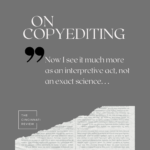 Caitlin Doyle: Russian playwright Anton Chekhov famously advised writers that a gun introduced in the first act should always go off in the second. Poet Brandon Amico aims his gun in the opposite direction: “In my book of distances a bullet fired / on page thirty-seven pricks the reader’s / thumb on six.” Amico deftly blurs the line that separates the universe inside of his “book of distances” from the world of his poem, in which the mysterious book has been figuratively placed. We can never be sure whether something will stay within the book’s covers or break though (like the thumb-pricking bullet) to penetrate the many boundaries that Amico tests—between poem and book, past and present, reader and words, self and other.
Caitlin Doyle: Russian playwright Anton Chekhov famously advised writers that a gun introduced in the first act should always go off in the second. Poet Brandon Amico aims his gun in the opposite direction: “In my book of distances a bullet fired / on page thirty-seven pricks the reader’s / thumb on six.” Amico deftly blurs the line that separates the universe inside of his “book of distances” from the world of his poem, in which the mysterious book has been figuratively placed. We can never be sure whether something will stay within the book’s covers or break though (like the thumb-pricking bullet) to penetrate the many boundaries that Amico tests—between poem and book, past and present, reader and words, self and other.
On a first encounter, “Book of Distances,” with its wild leaps and surprising juxtapositions, might discomfit a person accustomed to experiencing language as a linear and narrative medium. Yet the poem never alienates such a reader. What I admire about Amico’s work here is that the piece rewards both seasoned poetry-lovers familiar with navigating associative modes and readers who come to poetry in pursuit of more basic pleasures. By placing an imagined book inside of a poem, one form of written artifice inside of another, he asks us to reconsider the relationship between art and creator. He also spurs us to reflect on our own relationship to artistic works and those who make them. “Book of Distances” embraces difficulty and eludes easy understanding, even while inviting us into a world alive with images that we can see, touch, hear, smell, and above all, feel.
 Amico observes “how far Aeolus’s breath carries the resilient germ / of history, / genicular, Franklin and Eleanor / Roosevelt being fifth cousins.” He then informs us that “genicular has no closeness to genes / except in the brain’s language center,” information that is “covered in detail in chapter eight” of the book of distances. It’s no accident that Aeolus (known as the ruler of the winds) is a name shared by multiple characters in Greek mythology, all of them thought to be genealogically related, much like Franklin and Eleanor.
Amico observes “how far Aeolus’s breath carries the resilient germ / of history, / genicular, Franklin and Eleanor / Roosevelt being fifth cousins.” He then informs us that “genicular has no closeness to genes / except in the brain’s language center,” information that is “covered in detail in chapter eight” of the book of distances. It’s no accident that Aeolus (known as the ruler of the winds) is a name shared by multiple characters in Greek mythology, all of them thought to be genealogically related, much like Franklin and Eleanor.
When Amico notes how the “brain’s language center” joins “genicular” to “genes,” even though there’s no shared etymological connection, he extends his exploration of genetic ties to an examination of how we view units of language in relation to each other. As readers, we can’t help but develop an association between the two words, despite the poet’s insistence that none exists. This paradox comprises one of the many slyly artful strategies that Amico uses to interrogate how humans both inherit and create different forms of connectivity.
As the poem progresses, we move backward from chapter eight to the “fourth chapter” in the book of distances, which is “a compendium / of keys. / Office key, key to the city, / car, the shed . . .” Initially, the keys appear to promise another kind of linkage, a bridge between our yearning to enter closed-off spaces and our ability to tangibly do so. They also seem to glimmer as a possible symbol for the larger question of how we might unlock the poem’s complicated meanings. But when Amico observes that the locked shed can be entered without a key—“the frame/ can be shifted, the latch slid out”—he suggests that keys of any kind, whether literal or metaphorical, may prevent us from seeing that we can often access what we desire without relying on means beyond ourselves.
 Of course, no writer should introduce Chekhov in the first paragraph (is there any gun more loaded than that?) without returning to him. So it seems fitting for me to finish my appreciation of Amico’s poem by evoking, once more, the Russian maestro. As the piece approaches its end, Amico asserts that, whether or not we read the book of distances, “we still stretch / toward our lovers’ knees and our first homes.” Like a weapon introduced in a play’s first act and fired off later in the show, the knee image here brings us back to the word “genicular,” with its surprising meaning (of or relating to the knee), in the poem’s opening lines. Amico compels us to remember his use of “genicular” in association with Franklin and Eleanor Roosevelt. When we picture one of them reaching for the other’s knee, Amico’s exploration of the human hunger for connection finds its final, strangest, and most memorable embodiment.
Of course, no writer should introduce Chekhov in the first paragraph (is there any gun more loaded than that?) without returning to him. So it seems fitting for me to finish my appreciation of Amico’s poem by evoking, once more, the Russian maestro. As the piece approaches its end, Amico asserts that, whether or not we read the book of distances, “we still stretch / toward our lovers’ knees and our first homes.” Like a weapon introduced in a play’s first act and fired off later in the show, the knee image here brings us back to the word “genicular,” with its surprising meaning (of or relating to the knee), in the poem’s opening lines. Amico compels us to remember his use of “genicular” in association with Franklin and Eleanor Roosevelt. When we picture one of them reaching for the other’s knee, Amico’s exploration of the human hunger for connection finds its final, strangest, and most memorable embodiment.










